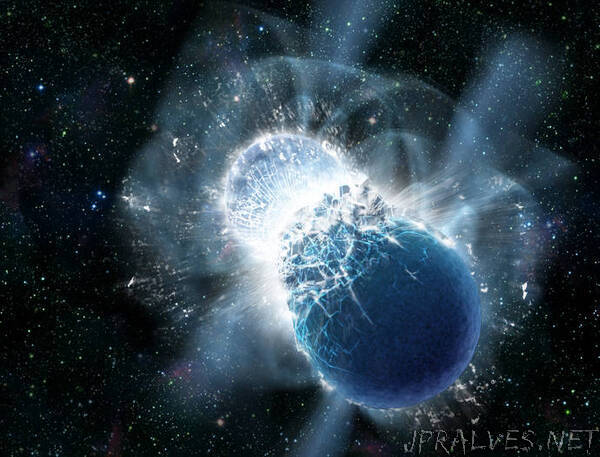
“
A new study lead by GSI scientists and international colleagues investigates black-hole formation in neutron star mergers. Computer simulations show that the properties of dense nuclear matter play a crucial role, which directly links the astrophysical merger event to heavy-ion collision experiments at GSI and FAIR. These properties will be studied more precisely at the future FAIR facility. The results have now been published in Physical Review Letters. With the award of the 2020 Nobel Prize in Physics for the theoretical description of black holes and for the discovery of a supermassive object at the center of our galaxy the topic currently also receives a lot of attention.
But under which conditions does a black hole actually form? This is the central question of a study lead by the GSI Helmholtzzentrum für Schwerionenforschung in Darmstadt within an international collaboration. Using computer simulations, the scientists focus on a particular process to form black holes namely the merging of two neutron stars (simulation movie).
Neutron stars consists of highly compressed dense matter. The mass of one and a half solar masses is squeezed to the size of just a few kilometers. This corresponds to similar or even higher densities than in the inner of atomic nuclei. If two neutron stars merge, the matter is additionally compressed during the collision. This brings the merger remnant on the brink to collapse to a black hole. Black holes are the most compact objects in the universe, even light cannot escape, so these objects cannot be observed directly.
“The critical parameter is the total mass of the neutron stars. If it exceeds a certain threshold the collapse to a black hole is inevitable” summarizes Dr. Andreas Bauswein from the GSI theory department. However, the exact threshold mass depends on the properties of highly dense nuclear matter. In detail these properties of high-density matter are still not completely understood, which is why research labs like GSI collide atomic nuclei - like a neutron star merger but on a much smaller scale. In fact, the heavy-ion collisions lead to very similar conditions as mergers of neutron stars. Based on theoretical developments and physical heavy-ion experiments, it is possible to compute certain models of neutron star matter, so-call equations of state.
Employing numerous of these equations of state, the new study calculated the threshold mass for black-hole formation. If neutron star matter or nuclear matter, respectively, is easily compressible - if the equation of state is “soft” - already the merger a relatively light neutron stars leads to the formation of a black hole. If nuclear matter is “stiffer” and less compressible, the remnant is stabilized against the so-called gravitational collapse and a massive rotating neutron star remnant forms from the collision. Hence, the threshold mass for collapse itself informs about properties of high-density matter. The new study revealed furthermore that the threshold to collapse may even clarify whether during the collision nucleon dissolve into their constituents, the quarks.
“We are very excited about this results because we expect that future observations can reveal the threshold mass” adds Professor Nikolaos Stergioulas of the department of physics of the Aristotle University Thessaloniki in Greece. Just a few years ago a neutron star merger was observed for the first time by measuring gravitational waves from the collision. Telescopes also found the “electromagnetic counterpart” and detected light from the merger event. If a black hole is directly formed during the collision, the optical emission of the merger is pretty dim. Thus, the observational data indicates if a black hole was created. At the same time the gravitational-wave signal carries information about the total mass of the system. The more massive the stars the stronger is the gravitational-wave signal, which thus allows determining the threshold mass.
While gravitational-wave detectors and telescopes wait for the next neutron star mergers, the course is being set in Darmstadt for knowledge that is even more detailed. The new accelerator facility FAIR, currently under construction at GSI, will create conditions, which are even more similar to those in neutron star mergers. Finally, only the combination of astronomical observations, computer simulations and heavy-ion experiments can settle the questions about the fundamental building blocks of matter and their properties, and, by this, they will also clarify how the collapse to a black hole occurs.”
